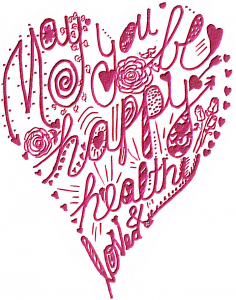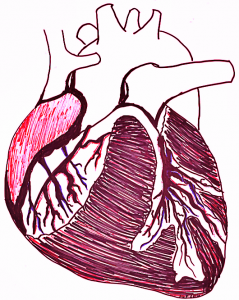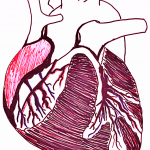 Living in a society where the pressure to succeed is on as early as preschool and time moves so fast it sometimes feels hard to breathe, I’ve found meditation to be cheap therapy for my generally order-driven, perfectionist self. It’s during this time, I quiet the chatter, nurture my spirituality, and bask in gratitude for the beautiful life I’ve been blessed to live. For me, quiet time happens on long [or short]runs, bike rides, practicing yoga, and driving in to work in the wee hours of the morning before most people consider getting out of bed. Personally, I’ve reaped the benefits of joy, peace, comfort, and strength with regular practice. For that reason, at age 4 and gifted with a vivid imagination and a love of stories, I recently started introducing meditation to my son and he’s digging it! Bring on the loving kindness!
Living in a society where the pressure to succeed is on as early as preschool and time moves so fast it sometimes feels hard to breathe, I’ve found meditation to be cheap therapy for my generally order-driven, perfectionist self. It’s during this time, I quiet the chatter, nurture my spirituality, and bask in gratitude for the beautiful life I’ve been blessed to live. For me, quiet time happens on long [or short]runs, bike rides, practicing yoga, and driving in to work in the wee hours of the morning before most people consider getting out of bed. Personally, I’ve reaped the benefits of joy, peace, comfort, and strength with regular practice. For that reason, at age 4 and gifted with a vivid imagination and a love of stories, I recently started introducing meditation to my son and he’s digging it! Bring on the loving kindness!
A couple weeks after we started this practice, we were in the car and my son was upset with his little brother. Then, the magic occurred. I heard him “catch” himself in the moment of frustration and start repeating quietly to himself “My feet are calm and still. My legs are calm and still. My body is calm and still.” Our nightly meditative practices were proving to be quite helpful as the car slowly became peaceful again. I was beaming with pride.
 A sense of calm is good for your heart. Anxiety and stress, not so much. As we venture into National Heart Health Month, we bring our attention to the prevention of cardiovascular disease (CVD) and stroke – the #1 killer in America. Despite the fact that CVD and stroke are 80% preventable, heart disease kills 1 out of 3 women. (American Heart Association)
A sense of calm is good for your heart. Anxiety and stress, not so much. As we venture into National Heart Health Month, we bring our attention to the prevention of cardiovascular disease (CVD) and stroke – the #1 killer in America. Despite the fact that CVD and stroke are 80% preventable, heart disease kills 1 out of 3 women. (American Heart Association)
So, what does heart disease have to do with meditation?
Meditation falls in the prevention and management category. Stress is a heavy hitter when it comes to heart health. Stress causes increased blood pressure, heart rate, and the release of stress hormones. Prolonged high levels of stress hormones can cause chronic inflammation, increased body fat, increased heart rate, and increased blood pressure, and therefore, an increase in the risk for CVD. Please note: The “stress hormones” provide necessary functions like helping us get out of danger fast by activating our “fight or flight systems.” When a stressful event occurs, we typically bounce back quickly. However, prolonged stress causes a prolonged release of these chemicals. Rather than bouncing back, our bodies are forced to function with high levels of stress hormones leaving us stressed out and at an increased risk for disease.
Research also shows that meditation reduces stress, increases happiness, improves overall health, boosts your immune system, increases grey [brain]matter (which helps manage your emotions), increases emotional intelligence, and boosts self-esteem by decreasing negative self talk. My favorite form of meditation is Loving Kindness Meditation. This meditative practice helps develop love and compassion for one’s self as well as others with well wishes. I’ve found this practice easy to complete pretty much anywhere and it leaves me with a sense of warmth and compassion. Here’s how to do it:
- Get into a comfortable position in a quiet place and close your eyes. (Note: In a stressful place, like driving home from work through traffic, this method is also beneficial – with eyes open, of course!)
- Take a couple minutes to notice your breath and observe how your body feels. If you notice that you’re not comfortable, move around until you are.
- Notice your thoughts, acknowledge them, and imagine them floating away.
- Begin your Loving Kindness practice by repeating the following quietly to yourself:
May I be happy.
May I be healthy.
May I be free from suffering.
May I be loved.
Notes: This is your practice, so the well wishes above are some of the most common. You have the artistic right to change these well wishes as you see fit. If you find starting with yourself challenging, you may also start with a loved one. 🙂
- Now, picture a loved one. Say their name to yourself, and wish them the same.
- Next, picture a person in which you feel indifferently – a stranger. Send your well-wishes to the stranger.
- Finally, picture someone who challenges you. Send well wishes to this person.
- Round out your practice with well wishes for “All Beings”:
May all beings everywhere be happy, healthy, free from suffering, and loved.
- Sit quietly for a few more breaths (or more!) and simmer in this moment. Take it all in. [The warmth and any feelings that arise from your practice.]
Take a couple minutes to try this now. Does it help you feel calm? Share your thoughts below!
Want to read more?
Check out this blog post summarizing some of the scientific research on Loving Kindness Meditation: 18 Science Based Reasons to Try Loving Kindness Meditation.
 This month, SAS Life is featuring heart-healthy posts in observance of National Heart Health Month. Read more....
This month, SAS Life is featuring heart-healthy posts in observance of National Heart Health Month. Read more....

2 Comments
Great post, Amanda! It is wonderful to get the benefits of meditation for ourselves - when we can help our kids get it too, then it is AWESOME! You have inspired me to try (again) with my kids... and myself! Be calm & be well! 😉
In Peace,
Jan
Jan,
So glad you enjoyed the post! Keep trying with your little ones. We could all use a little more calm and peace. 🙂
Amanda